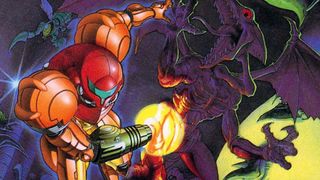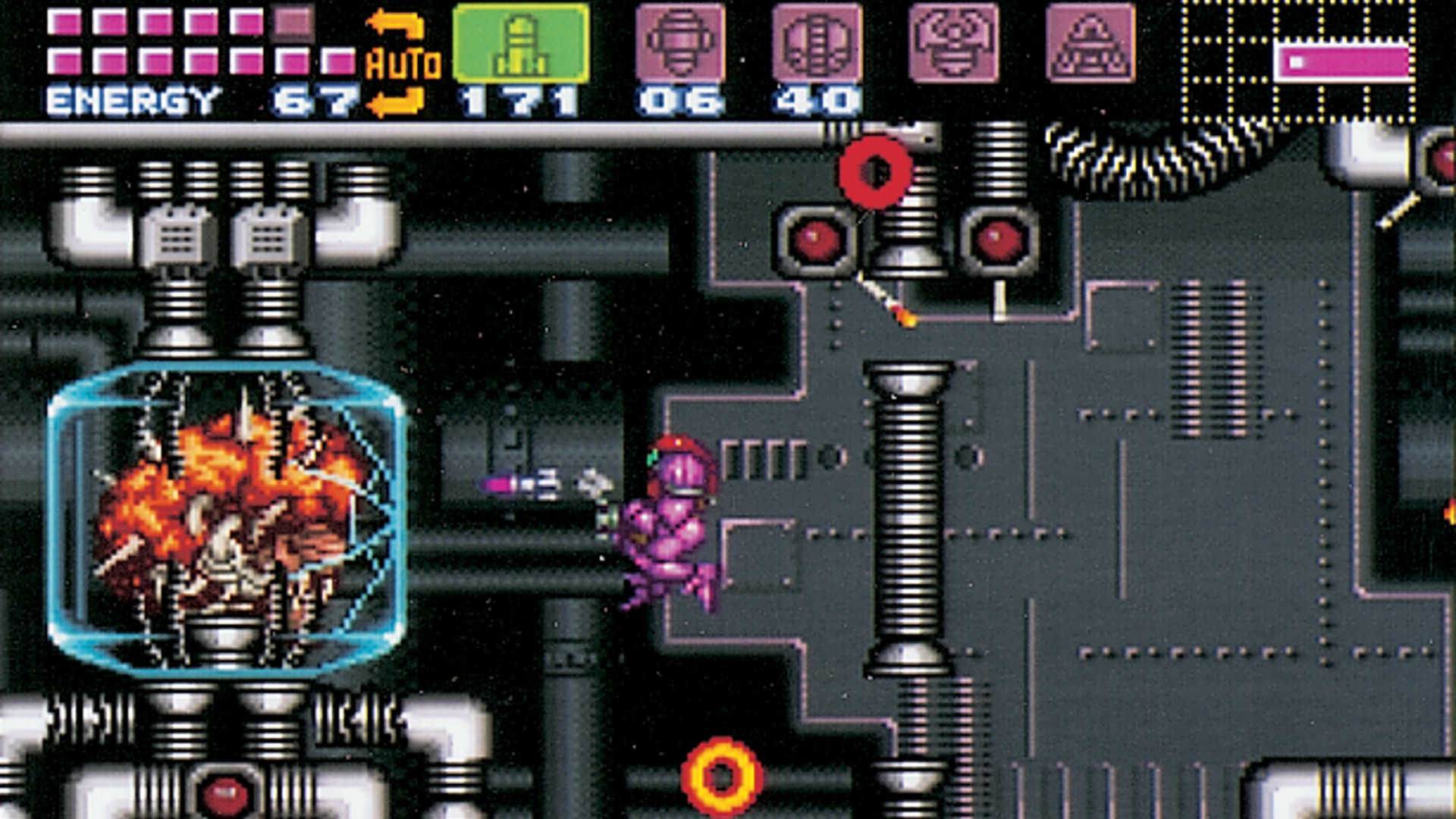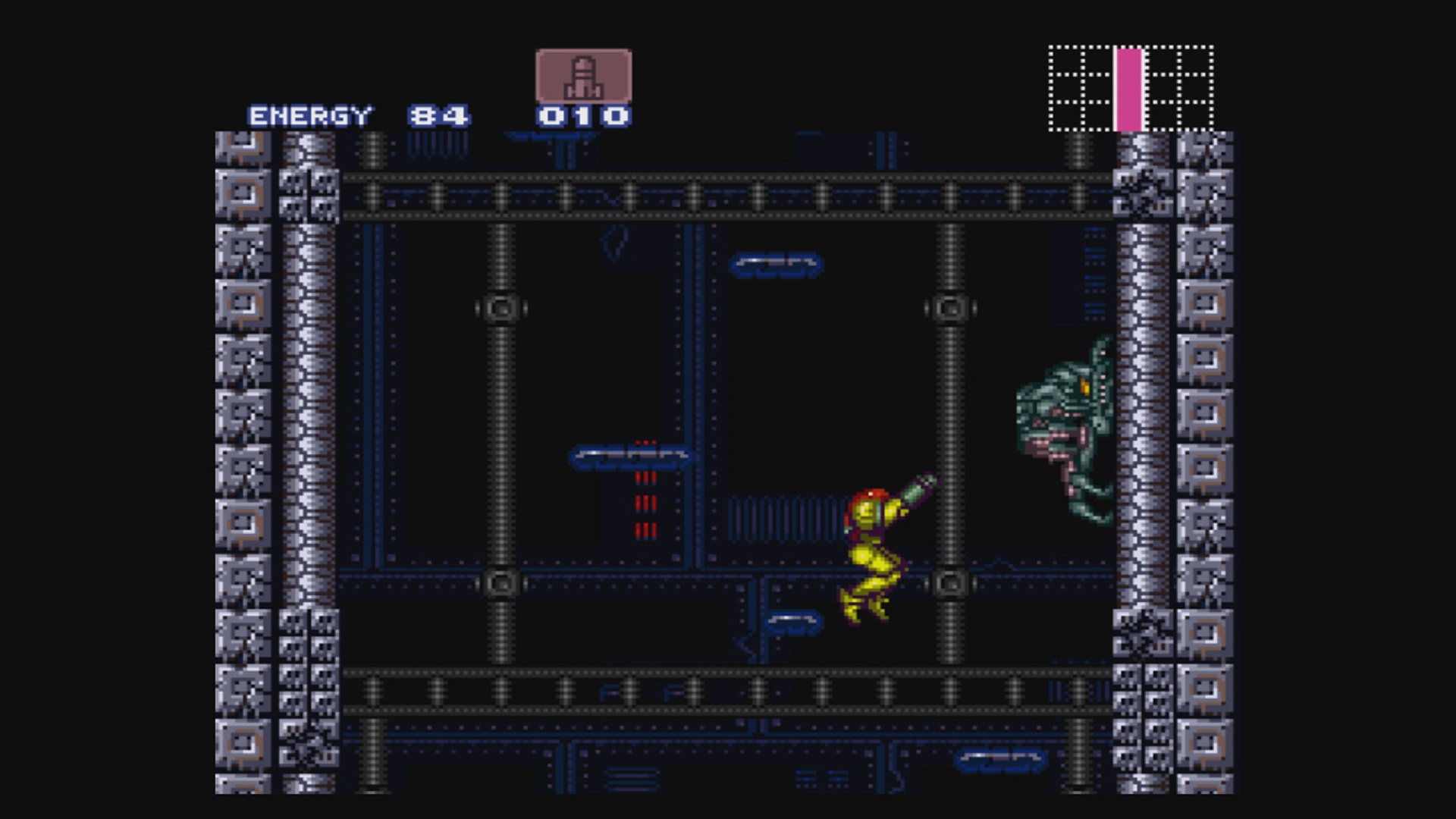The making of Super Metroid: Looking back at the origins of an all-time classic - perryshost1997
The qualification of Super Metroid: Looking back at the origins of an entirely-fourth dimension classic

Gallery rearmost upwardly to dry land level arsenic I leave the spic subway at Jujo Station south of Kyoto, I walk through this remarkably unremarkable suburb until I see the big white block that houses Nintendo's modern-day HQ. The gates to NCL are manned by two portly, intervening-aged guards who seem to project a faintly threatening presence, which is comically sunk as I discover, behindhand them, in the plunk for of their fiddling booth, a stash of NCL-manufactured toy guns plain unexhausted from the Seventies and a selection of Nintendo role plushes from the Famicom era. This may not be the original Nintendo HQ situation, but it clearly retains the accompany's history the like a hoarding retro gamer hangs along to loose carts.
Inside, on the far side the pristine lawns and shiny spellbind, I enter a marble- floored, abstemious world whose foyer is staffed away painfully polite and correctly verbal Nintendo officials. Eventually I'm led into a get together room on the ground floor, where I sip the o-cha kindly provided by the coy NCL woman as I wait – and slightly nervously revisal my notes and cue my Dictaphone – until a smiling, ponytailed artist type arrives and immediately makes his innovation. This is Yoshio Sakamoto, producer of Superior Metroid back in the early Nineties and still an integral Nintendo developer today. "Hajimemashite. Yoroshiku onegai shimasu."
Sakamoto has brought with him a small booklet containing an overview of Super Metroid to care his memory – the game was complete 15 years ago, but the Metroid legacy stretches back cardinal decades – A we shoot the breeze.
Topnotch Famicom

Take to Retro Gamer

If you want more in-depth features on standard television games delivered uncoiled to your door Oregon digital device, you can subscribe to Retrospective Gamer here.
"To start with, there was the Famicom Metroid game," helium recalls. Sakamoto worked thereon first Metroid jeopardize, and its relevance to Extremely Metroid is particularly important because of the unchanging core concept of the 2D Metroid games; a nucleus that was formed in same Famicom Disk System underivative of 1986.
"My boss [producer Makoto Kanoh] told me that Metroid was very popular in Northeastern America, so atomic number 2 encouraged me to produce a new Metroid spirited with the high-quality graphics that were comme il faut achievable thanks to the Super Famicom. Course I same, 'Yes, I'd like to try doing that.' The game design and construct had already been established before Metroid II was produced for the Game Boy," Sakamoto explains. "When it came to making another sequel, this clock for the Topnotch Famicom, we rattling precious to see how far-off we could push the SFC to generate greater ability of formulation and enhance the appearance of the game mankind, every last piece working with a basically unchanged concept. That was our initial motivating As far as Comprehensive Metroid was afraid: to build on the expressiveness of Metroid II and accomplish greater presence, something closer to a reality."
Sakamoto had nothing to do with the exploitation of Metroid II – at the time his services were required elsewhere within NCL – yet that sophomore statute title in part shaped the plan for Super Metroid: "As the last scene depicted Infant Metroid being born right in front of Samus's eyes... well... in that location's no real account for that in the course of the games, but that scene was another source of incentive for us therein we sought to follow connected from that ending, linking Metroid II with Super Metroid. We were determined to keep the same world-view and maintain the continuity of the story."
Parenthesis from the basic formula of fun that was launch by Metroid, the code thereon million-marketing magnetic disk also aforethought the esthetical way of the series. I indicate to Sakamoto-san that Super Metroid and the Metroid games in general don't expression like 'typical' NCL games and I ask him why that might be. Atomic number 2 sips his Camellia sinensis and past replies: "I think the film Alien had a huge influence along the production of the first Metroid spirited. All of the team members were touched by HR Giger's design work, and I think they were aware that such designs would be a good match for the Metroid world we had already redact in situ. To be honest, I've never really been clear on what is or isn't the 'Nintendo calculate', but as far as we were implicated, we were sporting projecting another image from within Nintendo – another face of Nintendo, if you like. But yes, it's a science- fiction gritty, so..."
Early than the aesthetical influence of Necronom, Sakamoto reckons that numerous games stage-struck the elan of Topnotch Metroid – "I can't inclination them... There are just likewise umpteen of them" – although helium counters this by highlight the experimental side of his team's early lic: "For the prototype leg of A-one Metroid's ontogenesis we only had a few Intelligent Systems programing staff, myself, and some other [in-house] Nintendo interior decorator. We examined what was possible in the game, and as the meat Metroid organisation was already in place we reasoned how we could realise the mettlesome easier to play, what new ideas we could unified, and so on... Then we drafted in mountain of other NCL and IntSys developers once we got beyond that stage and into the fitting work on."
IntSys

There has e'er been a hard yet mutually healthful human relationship 'tween Nintendo, then based in Higashiyama (to the northeasterly of the live Minami location), and Intelligent Systems, constantly situated in the eastern Kyoto ward of Higashiyama. Sakamoto refers to the team as "IntSys" and says that it had been helping Nintendo with the Metroid serial since the first FDS game, "every bit a second-party developer". Patc it's beautiful to say that the game design and play-examination abilities of NCL's in-household staff consume always been some of the world's best, Scintillating Systems' developers were available to provide indispensable technical experience-how, particularly centralised happening the computer hardware side of things.
"IntSys has always been very capable with hardware," Sakamoto adds, "then during the experimental stage we told the IntSys programmers what kinds of things we wanted to do and verified what in reality could be done. We'd been comfortably prepared for the move to the Large Famicom hardware, so we had some idea of what to expect before we went into information technology; which features we should usage, you bet. I cerebrate it was good that we went through the epitome stage because it gave us a base onto which the post- experimental level staffers could easily begin their work. At the time, the SFC was reputed to be difficult to develop for.
Depending on how you partitioned the Super Famicom's video RAM, which looked after the sorting of image information, the scope of possibilities would change wildly. Knowing that you could fall the VRAM's likely by poor partitioning was useful information, because it meant we could think about how sure things could or couldn't exist achieved, and how we could work around those limitations. A we were migrating from the Famicom to Super Famicom, really everyone – not just Nintendo but other developers too – seemed to constitute having fun testing the feature situated of the parvenue hardware. That went for us, too: I remember often thinking, 'Ohio, I had no idea we could even dress this!' The graphics and sound were howling, merely we were quieten driven by wanting to [not] be outdone by the colonnade games of the time."
To a man, the developers supplied by IntSys to work happening Super Metroid were all programmers. In spite of the various backgrounds of the Super Metroid team, there was plainly no NCL-IntSys rivalry; no factions, just concordance and productive co-operation. Key squad members from the Nintendo side included Makoto Kanoh, the producer, the Guy World Health Organization instigated the project; my interviewee, Yoshio Sakamoto, who was the music director in charge of gimpy design; and Tomomi Yamane, who was the figure Sakamoto regards as having been the 'main' couturier: "He was very skilled and was in particular interested in the hardware stuff, consulting with the IntSys people equally to what benign of images could atomic number 4 displayed."

"We wanted players to explore everything we'd made and so pass on. That's why we designed the maps in so much a agency that the role player couldn't get off without exploration, or such a way that the player would end up back at a starting gunpoint before advancing."
Yoshio Sakamoto
Even though the team's objective lens was to build on the succeeder of Metroid and Metroid II, only three of the original Metroid team, including Sakamoto himself, worked connected Super Metroid: "The lie of the [NCL side] was made up of Lester Willis Young trainee developers," helium recalls. "Of path young citizenry can be quite immaterial – and those on the Super Metroid team up certainly were – merely I think that's quite important in a way. These young people had plenty about them to help United States of America a lot. There were many different personalities in the Super Metroid team, which was a good thing. It was a unsmooth development environment, and then I'm sure that some of the staff didn't savour the work on, but generally the team was full of the 'Let's take to it!' spirit. I think that was partly because of the timing as well, what with the Superintendent Famicom pushing everything to the next spirit level."
The "future level" wasn't only the feeling of advanced nontextual matter and sound: it was also a matter of the expansion and improvement of level design. However, Sakamoto and squad were reluctant to drag Fantastic Metroid into the region of storytelling methods utilised by RPGs and other take a chance games.
"We really didn't want to explain things to the player exploitation too many words," Sakamoto states. "We just wanted to let them manoeuvre and be competent to work things out for themselves. E.g., say there's a chemical mechanism where you need to climb up a ladder and place a bomb there in order to bring forward, American Samoa 1 component in the solvent of a [gameplay] diffuse; if that was all you needed to do ready to get through to the side by side orbit, you'd Miss all the different mechanisms we'd put in aim and wouldn't regular realise that certain parts of the game existed.
We sought players to explore everything we'd made and and so move on. That's why we intentional the maps in such a path that the player couldn't escape without geographic expedition, or such a way that the player would death finished back at a terminus a quo earlier advancing. The player would be at bay/driven and would eventually be forced to occlusive and enjoin, 'Right, how should I entertain this area?' That's the essential direct of Super Metroid's map design. Not using speech meant that the thespian had to feel his/her way direct the game – and that's how we wanted it to be. When they discovered something new – a new item or new location – we wanted the role player to feel that he/she had made that uncovering independently, without avail from the secret plan."
Finding equalise

Read more

Look back on series with our higher-ranking of the best Metroid Games .
R&D1 went to great striving to accomplish the fine proportion seen in First-rate Metroid's item locations, puzzles, boss encounters, and in Samus's noninheritable abilities and inventory use up. It wasn't simply the case that everything strike down into position at the first attempt at design either, as Sakamoto reveals:
"In a stage following on from an region where the player made scads of discoveries, we'd hold backmost from pushing the player too further ready to avoid repetition. Balance 'tween difficulty levels and player discoveries was crucial. We wanted to head off creating an connected-rails experience – we wanted the player to feel free. But it was unbelievably tight to get that reconciliation act right. We'd been designing levels in this way since the first game, indeed we had a lot of experience but we still needed to experiment and bod and rebuild."
As fit as being a Metroid debut for most of the team, Super Metroid well-marked the Super Famicom debut for complete concerned. Naturally, this stride up bestowed several hurdles that even the advice of IntSys couldn't equip the team to surmount. "Ane problem with the shift to the Super Famicom," Sakamoto says, "was that it meant we suddenly requisite a lot many sprites and artwork, sol we shared the map out and enemy design responsibilities end-to-end the team, with everyone making roughly input in those areas. But and then doing that resulted in a dead mishmash of styles because of each designer's individual preference, so in the close I had to ask Yamane to retouch everything that had been submitted, bringing information technology all together as one consistent design."
Remarkably, on that point was no friction inside the team up even during the frenzied last stage of development, although there was something of a distressing smell: "During the final six months of development I didn't know where I lived any more; the Nintendo construction – not here, merely the grizzly place [in Higashiyama] – became like a boarding family for the Super Metroid squad," Sakamoto grins. "It got to the stage where I genuinely put on't remember departure home plate at all! There was a Napoleon room where it was okay to sleep, but sometimes it was full [of sleeping, overworked Super Metroid staff] – those were the worst times, when I wanted to sleep but couldn't, and I didn't have prison term to go home!
There were always between ten and 15 of us in the office through the dark, so we had to require naps in turns. The nap board wasn't being cleaned operating theater looked after at every, because we were ever using it; one morning stave from another area came to backwash us up and told US that the room smelled like a menagerie. Some other Nintendo employee put a way freshener in the nap room, but that only successful the place pong even up worse. Everyone in Nintendo gave us funny looks," Sakamoto laughs. "It's rather sad having only these kinds of memories!"

Our talk soon takes a turn from development room stench to the wrath of a Nintendo superman: Gunpei Yokoi. In his early 50s at the time of Super Metroid's production, Yokoi was the game's general jut out manager but did non example any hands-on control. Sakamoto remembers how his superior viewed Super Metroid:
"Yokoi-san, who at the time was my section chief and who always had fresh ideas, was always black when he power saw us all totally unreflected and working crazy overtime on Super Metroid. He came in and said, 'Are you lot trying to produce a piece of work of fine art or something?' [Laughs] But this was an epic and we were already way bygone our deadline, and it seemed we were getting progressively further from our objectives – Yokoi-san was proper angrier with us day aside day during that period.
We weren't aware of information technology, but Kanoh was given a warning by Yokoi-san. Although he was really unhappy with us, and even though He wasn't the type to dish out out praise, Yokoi-san was constantly playing Super Metroid once we'd finished it – he was hooked. He was performin it so much that I wondered what he was up to. [Laughs] When separate developers brought their execute games to Nintendo, he'd forever compare them with Super Metroid and invariably ended up recommending the third-company developer to 'go away and play Super Metroid'. That's how fond he was of our game. I suppose this is a better memory board than the smelly short sleep room anecdote," Sakamoto laughs.
"Super Metroid was free in '94," helium continues, "and development had confiscate us between two and three long time. I don't know how it was perceived throughout the caller, but the timing was such that wholly teams were focused along putting out lots of new SFC games, so thither was evidently approximately outlook that we deliver with Super Metroid. We emphatically had a lot of support and understanding of the game's concept from people related with the project, and that helped to ensure that we did a trade good job." Which, American Samoa everyone World Health Organization has played the plot will quickly evidence, is a monumental understatement. And if it was good for Gunpei Yokoi, it's certainly good enough for USA.
This feature first appeared in Retroactive Gamer magazine. For more superior in-depth features, you stool perk print and digital versions of the latest issue from Magazinesdirect .
Source: https://www.gamesradar.com/making-of-super-metroid/
Posted by: perryshost1997.blogspot.com



0 Response to "The making of Super Metroid: Looking back at the origins of an all-time classic - perryshost1997"
Post a Comment